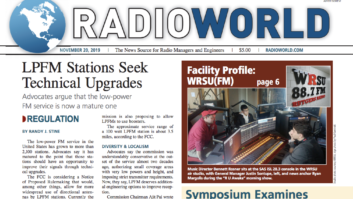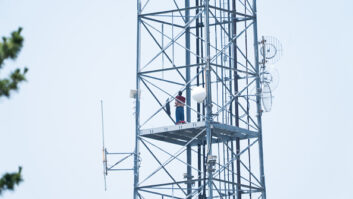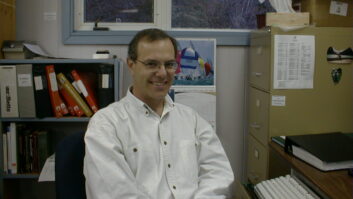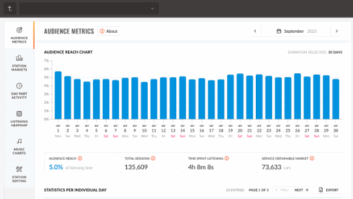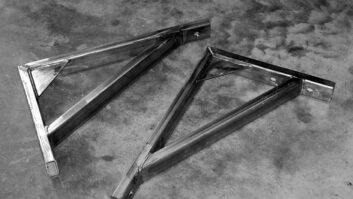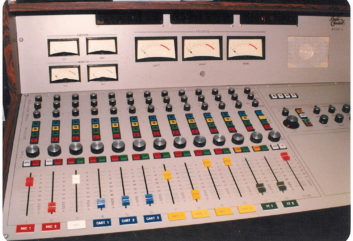
The author was director of engineering at Drake-Chenault Enterprises Inc. from 1974–1989.
A recent Tom Vernon article (“The Time Has Come to Talk of Many Things, of Reels and Carts and Carousels, and Automation Things,” Oct. 23, 2019) touched on the history of automation. At the invitation of Radio World, I’d like to share thoughts about my own experiences that readers may find interesting.
Drake-Chenault Enterprises was a successful producer of music formats for automation, with about 300 clients stations across the country. The production of music programming tapes for automated radio stations at Drake-Chenault evolved into a highly regimented process that produced a polished, consistent product week after week, month after month. A typical automated broadcast station could be airing tapes that were anywhere from one week to one year old. There needed to be absolute consistency in programming, studio engineering and tape duplication in order for the final product to sound seamless on the air.
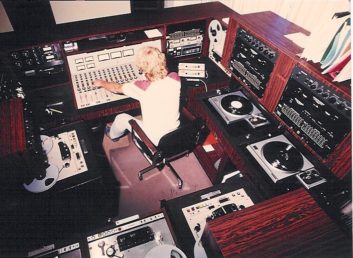
In 1974, Drake-Chenault produced music tapes for several formats: XT-40 (top 40), Hit Parade (AC), Solid Gold and Classic Gold (oldies) and Great American Country. There were two “house announcers” who did the voicing for these formats. Billy Moore voiced XT-40, Hit Parade, Solid Gold and Classic Gold formats; Bob Kingsley voiced Great American Country. Once a week, Billy and Bob would come to the studios and record the voice tracks (VTs) for all the music reels to be produced that week. The music librarian would pull the LPs and 45s that were needed for each reel. The studio engineers would then mix the music from records with the VT tape to produce a finished master reel. The masters were recorded using 1-mil tape, so we got up to 90 minutes, usually 20–25 songs, on a 10-inch reel.
ONE SECOND EARLY
Broadcast automation equipment of the ’60s and ’70s was usually limited to “easy listening” music formats, because the hardware of the era wasn’t capable of executing a tight, fast-paced pop music format. With easy listening, it was OK if there was some silence between songs; not so with top 40! Top 40 needed tight segues, jingles, spots, time announce, weather and other elements in rapid succession. The problem was how to make an automation system run tight and quick?
The answer was developed by D-C: We put the 25 Hz “cue” tones at the end of each song one second early, so the automation equipment had a “one-second head start.” This would compensate for the start-up delay of the reel-to-reel playback decks, and yield tight segues without any “wow-in.”
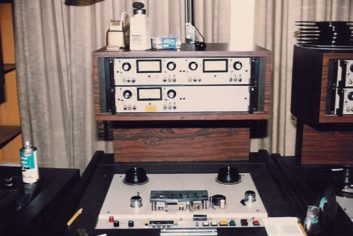
The next challenge was to figure out how to put those inaudible 25 Hz tones at the end of each song, but precisely one second early. The answer will explain why we used multitrack mastering decks in the D-C studios.
Master tapes were recorded at 7.5 inches per second on custom three-track recorders. At the end of each song on the tape, a cue tone was recorded on a separate track. However, it wasn’t the usual 25 Hz cue tone and it wasn’t recorded one second early. It was a 1 kHz tone that was recorded in “real time,” i.e., at the logical segue point for the song, not one second early.
[Read more great articles from the Nov. 20 issue of Radio World]
Because this tone was audible (through a “cue” speaker) and was on a separate track, it was easy for the studio engineer to place it at the proper segue point, tight against the end of the song. The cue tone could be re-recorded as necessary until it’s placement was appropriate to the song ending. The one-second advance would happen when the master tape was duplicated.
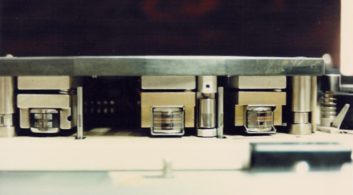
Drake-Chenault’s standards for technical quality were absolute, and our studio engineers were perfectionists. We carefully watched levels, double-checked cue tone placement, fixed fades and manually edited out tics and pops! The studio staff would spend hours with a razor blade removing tics, pops and other noises that were common on vinyl records. LP tracks were often used (after editing, to match the 45 “hit” version) because the quality of LP vinyl was usually superior to the poly-plastic used to press 45 rpm singles.
To ensure technical consistency, a full set of level, EQ and head alignment tones were recorded at the head and tail of each master tape. We went to great lengths to be sure that there was no phase error in the audio, which would cause a degraded signal when a stereo station was heard on a mono receiver. All audio was checked using a vectorscope to ascertain mono-compatibility. We would often discover phase error in 45s and LPs; it was corrected before transferring the audio to a master tape. The turntables were equipped with Shure V15 cartridges and Marantz “audiophile” preamps. The audio path was clean and direct, without any “house EQ” or level compression. Voice tracks were recorded using Shure SM7 microphones.
DUPLICATION
Once a master tape was produced, we made second-generation copies that were shipped to our client stations.
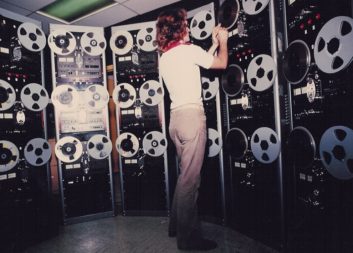
Tape duplication was done in-house, using 25 Technics RS1500 two-track recorders. The system ran “tails-out” so the audio was actually being recorded in reverse. A three-track master deck was used to play the master tape, which had left, right and cue channels. When the system sensed a 1 kHz cue tone on the master tape, it triggered the 25 Hz tone, which was injected into the left channel audio. When the 1 kHz master cue ended, the 25 Hz tone generator would stay on for one additional second, hence “stretching” the 25 Hz cue tone so it started exactly one second before the 1 kHz cue on the master. This one-second pre-roll was controlled electronically, so it was exact and consistent.
The duplicating system produced copies that were flat to 15 kHz, and typically had less than 30 degrees of phase error at 10 kHz. To achieve this level of quality, each “slave” recorder was hand-aligned to each new “pancake” of tape before the duplication process was started. The duplicating engineer would align the record head of each recorder for zero phase error. Then the master tape would be started and the duplication process would begin. After duplication, each tape copy’s alignment tones were checked on a special “QC” deck. We again verified level, stereo balance, EQ and phase (head alignment) before the tape was shipped.
Drake-Chenault produced about 1,000 music format reels each week. In the 15 years I was there, we never missed a deadline!
For more details, visit www.drakechenault.org and click on “Behind the Scenes in the Production Dept.”
